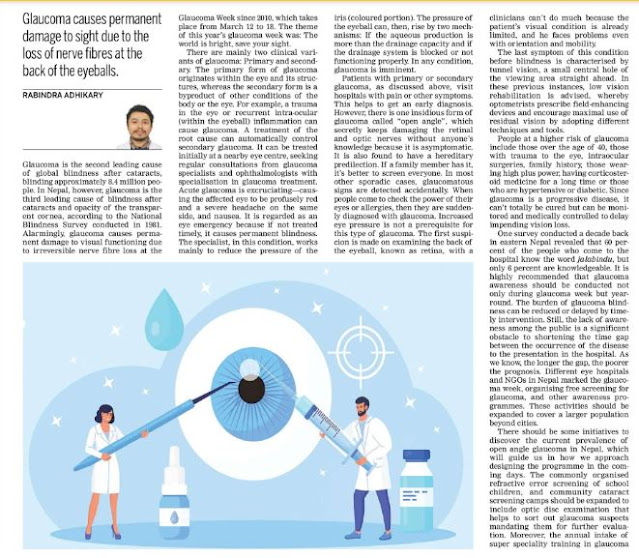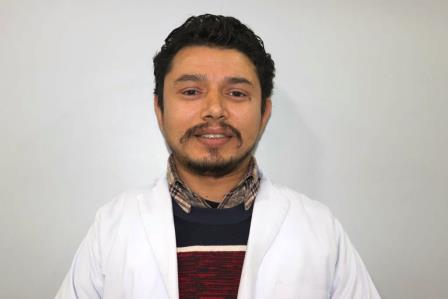Rabindra Adhikary  |
| The article was published in "The Kathmandu Post", on 21 March 2023 under the Opinion Page article entitled, "Beating Glaucoma Blindness" |
Glaucoma is the second most
leading cause of global blindness after cataract causing
approximately 8.4 million people
blind. But in Nepal, according to the National
Blindness Survey conducted in 1981, it is the third leading cause of
blindness after cataract and opacity of transparent cornea. The really alarming
fact of glaucoma is that it causes permanent damage to visual functioning due
to irreversible loss of nerve fibers at the back of the eyeball. Hence, the
target organs of glaucoma are the nerves responsible for transferring visual
messages to the brain from the retina. Optic nerves are, if damaged once, never
recovered. Owing to this blinding dreadfulness of glaucoma and its incorrigible
consequences in the society, World Glaucoma Association and World Glaucoma
Patient Committee is jointly organizing world glaucoma week since
2010 and this year it was celebrated from 12th March to 18th March, 2023. The
motto of these campaigns lies on the grounds that health personnel only can't
address the glaucoma that's hidden in the society and to which shared alertness
is warranted to encourage all to have periodic eye check-ups.
There are mainly two clinical
variants of glaucoma according to the origin of causation: primary and
secondary. The primary form of glaucoma originates from within the eye and its
structures whereas the secondary one is a byproduct of some other conditions of
the body or eye. For example, trauma in eye or recurrent intra-ocular (within
eyeball) inflammation can cause glaucoma. So that in secondary glaucoma
treatment of the root cause can automatically control glaucoma. The first
treatment of glaucoma can be done at a nearby eye center but for expert
management, one has to seek regular consultation from glaucoma specialists;
ophthalmologists who have specialized knowledge in the treatment of glaucoma.
Acute form of glaucoma is
very painful causing the affected eye profusely red and severe headache in the
same side, with a feeling of vomiting. It is also regarded as the eye emergency
because if the patient does not get treatment on time the eye gets permanently
blind. The health personnel in this condition work mainly to reduce the pressure
of the eyeball (intra-ocular pressure) which is causing all the symptoms.
To maintain eyeball
integrity there should be some liquid inside the eye which we call aqueous. It
is very similar to water and is produced by the structures within the eye (ciliary
body). The water then flows out through a natural drainage system located in
the angle between the cornea (outer glassy clear portion) and iris (colored
portion of the eye). The pressure of the eyeball can rise by two mechanisms: if
the aqueous production is more than drainage capacity and if the drainage
system is not working properly or is blocked. In both conditions, glaucoma is
imminent.
The cases with primary acute
glaucoma or secondary glaucoma, as discussed above, come to the hospital door as
is accompanied by pain or other symptoms and are hence generally detected
earlier. But there is one insidious form of glaucoma called 'open angle' which
secretly keeps damaging the retinal nerves and optic nerves without anyone
knowing because it is asymptomatic. It is also found to have a hereditary
predilection; so if a person in a family has it, better screen all members. In
most other sporadic cases, glaucomatous signs are detected accidentally. When
people come to check the power of their eyes or allergies, then they are
suddenly diagnosed with glaucoma. Increased eye pressure is not a prerequisite
for this type of glaucoma. The first suspicion is made on examining the back of
the eyeball that we call retina through an instrument (ophthalmoscope) that
looks like a torchlight. After that, we have to do a cascade of examinations
before coming to the final diagnosis to assess visual field, eyeball pressure,
central thickness of cornea, and layer-wise photographic analysis of retina. If
ever a patient with symptoms of primary open angle glaucoma comes to hospital,
it is certainly understandable that the treating clinicians can't do much
because his visual condition would be already drastically limited and he faces
problems even on orientation and mobility.
The last symptoms of this
condition before going blind is characterized by tunnel vision, a small central
hole of the viewing area straight ahead. In these last instances low vision
rehabilitation is advised whereby optometrists prescribe field enhancing devices
and encourage maximal use of residual vision by adopting different techniques
and tools. People who are at a higher risk of glaucoma include age above 40,
trauma to the eye, intra-ocular surgeries, family history, wearing high plus
power, having corticosteroid medicine for a long time, and hypertensive or
diabetic. Since glaucoma is a progressive disease it is as such can't be
totally cured but can be monitored, medically controlled in order to delay the
impending vision loss.
One
survey conducted a decade back in eastern Nepal revealed that 60% of
the people who come to hospital know the word 'jalabindu' but only 6% have
knowledge about it. So, it is highly recommended that glaucoma awareness should
be conducted not only in the glaucoma week but year round. The burden of
glaucoma blindness can be reduced or delayed by the proper intervention on time
but the lack of awareness among the public is creating a big obstacle to
shorten the time gap between the occurrence of the disease to the presentation
in the hospital. As we know, the longer the gap the poorer is the prognosis.
Different eye hospitals and NGOs in Nepal marked this week by organizing awareness
programs and freely screening for glaucoma. These activities should be expanded
to cover a larger population beyond cities in order to realize the theme of
this year's glaucoma week: The World Is Bright, Save Your Sight.
There should also be some
initiatives to find out the current prevalence of open angle glaucoma in Nepal
which will guide us how we approach designing the program in the coming days.
Also, commonly organized refractive error screening of school children and
community cataract screening camps should be extended to include optic disc
examination that helps to sort out glaucoma suspects mandating them for further
evaluation. On top of that, the annual intake of super specialty training in
glaucoma should be increased and made more effective to fulfill the nation's
needs. There is also a dire need in upgrading the existing secondary and
tertiary level eye hospitals in terms of equipment, technology and human
resources to run glaucoma clinics regularly.
To access the article, click here: "Beating Glaucoma Blindness"





0 Comments